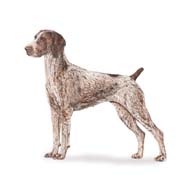INSTANT PROMOTION - LIMITED TIME OFFER - GET YOUR PUPPY COUPON TODAY
Hicksville: 516-938-7877
Lynbrook: 516-825-7877
Hicksville: 516-938-7877
Lynbrook: 516-825-7877
Currently we do not have any German Shorthaired Pointer Puppies available.
Please complete the form below to be notified when they are back in our stores.

Care and Training:The smooth coat of the Pointer is very easy to groom. Just brush regularly with a firm bristle brush and bathe only when necessary. A rub with a piece of toweling or chamois will leave the coat gleaming. Check the feet also, especially after the dog has been exercising or working. Dry the dog thoroughly after hunting to prevent chilling. Examine the ears regularly. This breed is an average shedder.
Exercise is of paramount importance for these tireless energetic animals. They are more than a match for even the most active family and they should not be taken on as family pets unless they can be guaranteed plenty of vigorous exercise. They need to be taken on a daily, brisk, long walk, jog or run alongside you when you bicycle. If under-exercised, this breed can become restless and destructive.Living Environment: This breed is not recommended for apartment life and does best with a large yard and an active, athletic family. They may be able to jump any fence that is lower than 6 feet tall. Under exercised, bored GSPs are great escape artists.
Health Issues: Usually a healthy breed but some are prone to epilepsy, hip dysplasia, hermaphrodism and lymphedema. Some minor concerns are CHD, entropion, gastric torsion, VWD, pannus, OCD.
Life Span: 12 -15 years Litter Size: 2 – 3
Origin: While not proven, some think that the German Shorthaired Pointer is a descendant of different types of German hunting, scent hounds, trail and track dogs, such as the Old Spanish Pointer, German Bird Dog, Hounds of St. Hubert (Bloodhound types), and the Foxhound. Later the English Pointer was crossed in to add speed and endurance. The German hunters were after an all-purpose utility dog that not only had a good nose, but could point, track, was an excellent retriever, gun-dog, in both field and water for both feather and fur. They also wanted a dog that was an excellent weekend hunter, but made a good family companion and watchdog. The German Shorthaired Pointer was recognized by the AKC in 1930. The German Shorthaired Pointer contributed in the development of the German Wirehaired Pointer. The German Shorthaired Pointer’s talents are show dog, obedience, gun dog, retrieving, tracking trials, field trials, and hunting tests.
AKC Group:Gun Dog, AKC Sporting Registries: CKC, FCI, AKC, UCK, KCGB, CKC, ANKC, NKC, NZKC, APRI, ACR, DRA